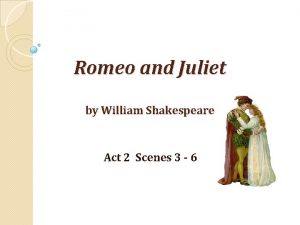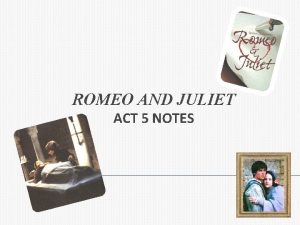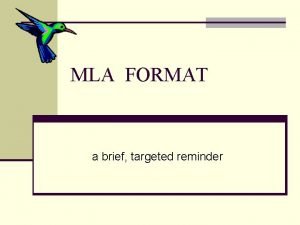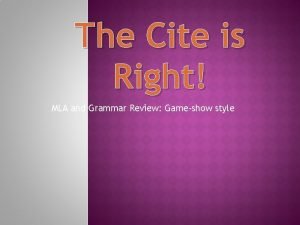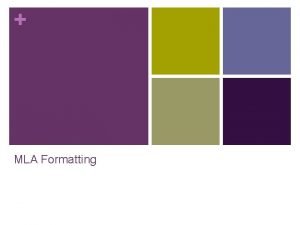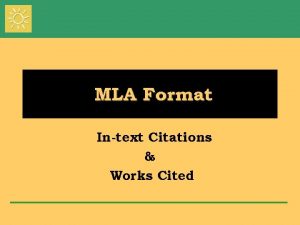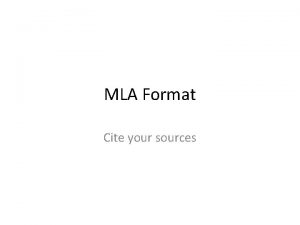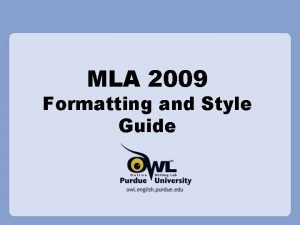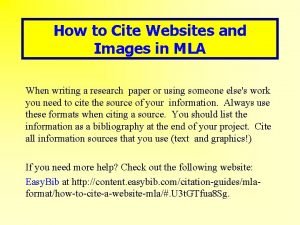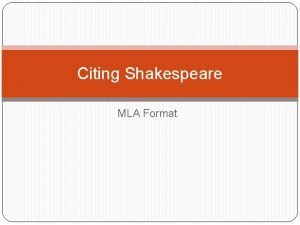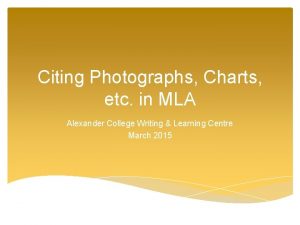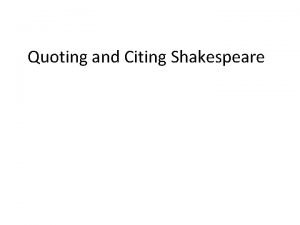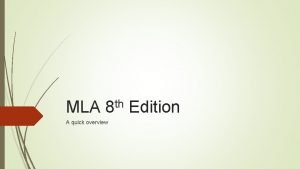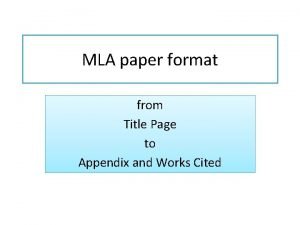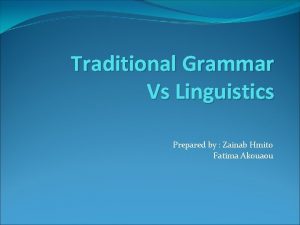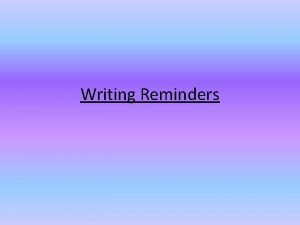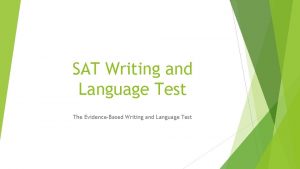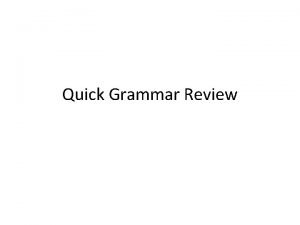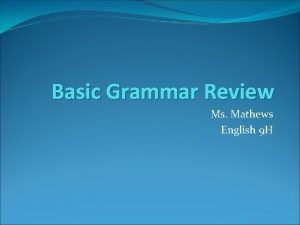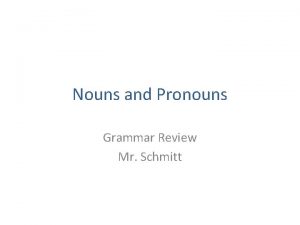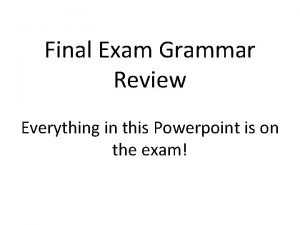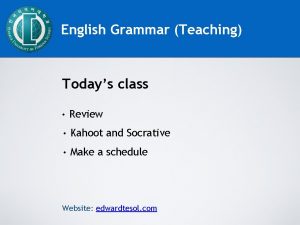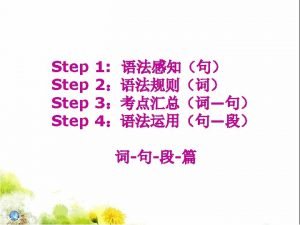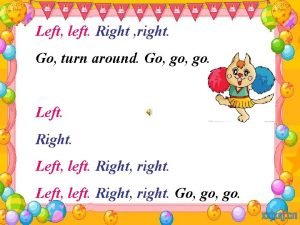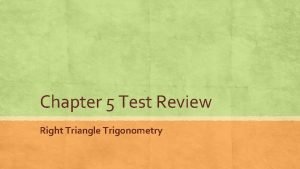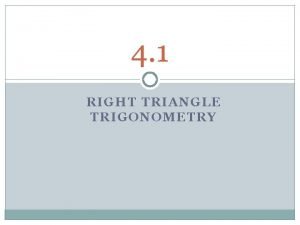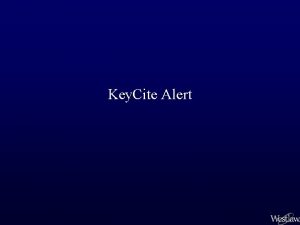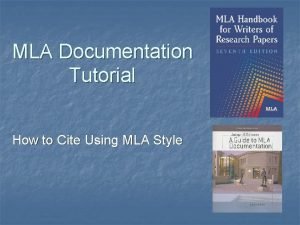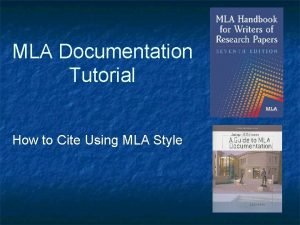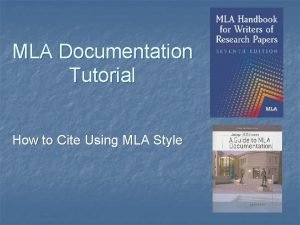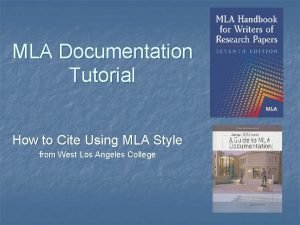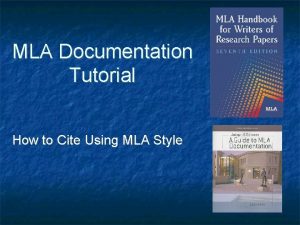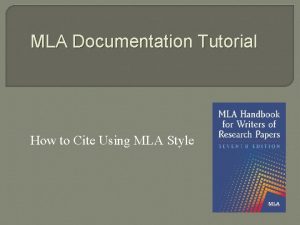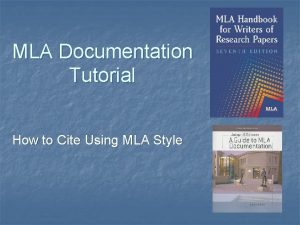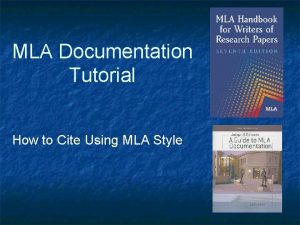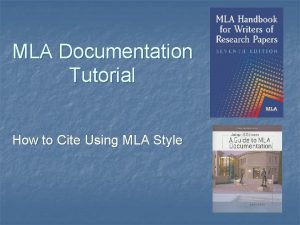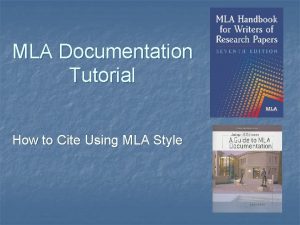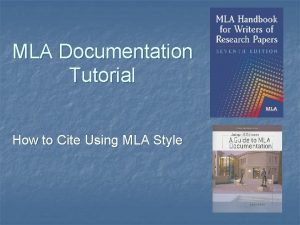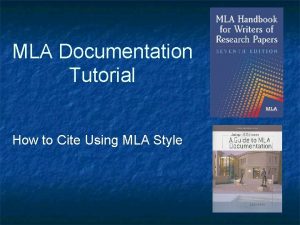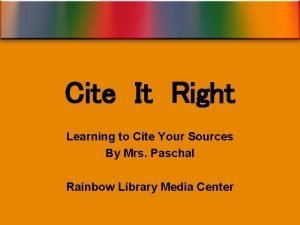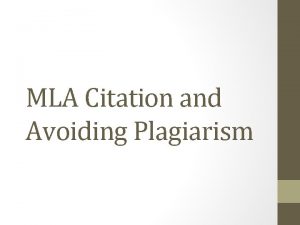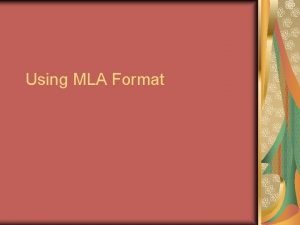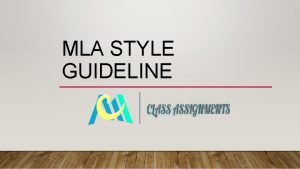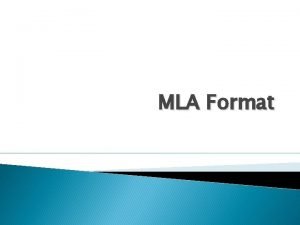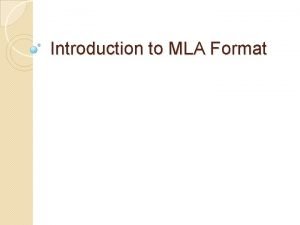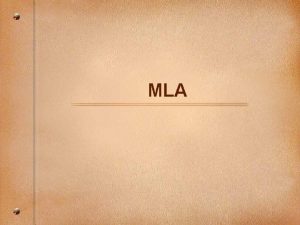The Cite is Right MLA and Grammar Review



































- Slides: 35

The Cite is Right! MLA and Grammar Review: Game-show style

Rules �There will be 4 groups of 5 – 6 students �Each slide will contain a question for each of the groups to answer You will answer in the style of final jeopardy: each group will write their answer down (Large) on a piece of paper, then all three groups will display their answers simultaneously

� Each question will have a point value at the top of the slide. � A correct question earns you points �An incorrect question merits a loss of that many points. � Different questions will have different points based on the difficulty.

� Any final questions?

� Which of the following is a proper MLA heading for a paper A � � � � Last name, First name Professors name Date ENG 160 -22 C First and Last name Professors name Date Title of Essay B First and Last name Professors name ENG 160 - 22 Date D First and Last name Name of class Title of Essay Professors Name

�B �First and Last Name �Professors Name �ENG 160 – 22 �Date �This is the standard heading for MLA formatting.

� True / False � If you draw information from a work, it should always be accompanied by both a quote and an in-text citation.

� False. � Whenever you offer a quote, you should leave an in-text citation, but you don’t always need a quote (You can paraphrase). � Quote or no quote, a citation is always needed.

� In MLA formatting, the page should have a set standardized margin size. This size is… � 5 Centimeters � 1 Inch � 2 Inches �. 5 Inches

� Option � This #2 – 1 Inch is not only the MLA standard, this is the default for Microsoft Word.

� True / False � If you find an unusual source that MLA handbooks do not cover, (Such as a tweet, a vine, or other new media) then it is impossible to cite that source and it should not be used.

� False! � To cite a source for which MLA does not provide guidelines, look for models similar to the source you are citing. Give any information readers will need in order to find your source themselves—author, title, subtitle, publisher, and/or sponsor, medium, dates, and any other pertinent information. You might want to try out your citation yourself, to be sure it will lead others to your source.

� True / False � In addition to quoting, it is appropriate to paraphrase an outside text, so long as you cite it.

� True! � So long as the original source material is cited, paraphrasing is an additional way to incorporate outside information into your writing. This works especially well with messy quotes or if you’re broadly summarizing an entire piece.

� True / False � There should be an in-text citation at least once in every body paragraph for a good paper, and more is better.

� False � While incorporating additional quotes and citations is helpful (To an extent), there’s no hard-and-fast rule that should be followed. � Additionally, using too many quotes can be harmful: especially if you have more quotes than your own writing.

� When you use a block quote… a. You should indent an additional two inches (or twenty spaces) from the left-hand margin. b. You should indent an additional one inch (or ten spaces) from the left-hand margin. c. You should center the quotation in the middle of the page.

� B! � You should indent one additional inch from your usual margins.

� With a. b. c. d. a block quote you should… Place the entire quote in quotation marks, and place final punctuation (such as periods) after the citation. Do not use any quotation marks and place the final punctuation after the citation. Use quotation marks but place the final punctuation before the citation. Do not use any quotation marks and place the final punctuation before the citation.

�D – No quotation marks, punctuation before citation! � Example Block quote… At the height of its glory in the Roman-Byzantine age, when it had an amphitheater, public baths, aqueducts, and sewage pipes, half a million people lived in Antioch. Today the population is only 125, 000. With sour relations between Turkey and Syria, and unstable politics throughout the Middle East, Antioch is now a backwater—seedy and tumbledown, with relatively few tourists. I found it altogether charming. (123)

Which of the following in-text citations are correct? � “Family devotion only goes so far for most people on reaping day. What I did was the radical thing” (Collins 26). � “Family devotion only goes so far for most people on reaping day. What I did was the radical thing. ” (Collins 26) � “Family devotion only goes so far for most people on reaping day. What I did was the radical thing” (Collins, 26). � “Family devotion only goes so far for most people on reaping day. What I did was the radical thing (Collins 26). ” �

� Option #1! � “Family devotion only goes so far for most people on reaping day. What I did was the radical thing” (Collins 26). � The quote ends before anything else. Unlike in writing dialogue with regular quotation marks, the period goes at the end of everything rather than inside the marks: this is because the citation (Which has to go outside the quote) is part of the sentence.

� Which of the following in-text citations is correct? � “What charge do you bring against the javelin” (Ovid VII. 1131)? � “What charge do you bring against the javelin? (Ovid VII. 1131)” � “What charge do you bring against the javelin? ” (Ovid VII. 1131). � “What charge do you bring against the javelin? ” (Ovid, VII. 1131)

Option #3! � “What charge do you bring against the javelin? ” (Ovid VII. 1131). � When you’re citing something with unusual punctuation, like a question-mark, that punctuation goes inside the quote: this is because it is essential to the quote making sense. � There is still a period at the end, because the quote (? Included) is part of a larger sentence. � The citation remains the same: Author’s name and page number with no additional markings inside of a parenthetical. �

� Which of the following citations is correct? � Ovid. “The Metamorphoses. ” Trans. Charles Martin. New York: Norton, Print. � Ovid. 2004. The Metamorphoses. Trans. Charles Martin. New York: Norton, 2004. Print.

� Option #2! � Ovid. The Metamorphoses. Trans. Charles Martin. New York: Norton, 2004. Print. � When citing a full work, such as a novel, you italicize the title. � Articles, poems, plays, and excerpts from anthologies go in quotation marks.

� In the following citation: � Ovid. The Metamorphoses. Trans. Charles Martin. New York: Norton, 2004. Print. � Can you outline each part of this citation? (Map it out, explain what each part is using your handbook as a model!)

� Authors last name, first name. Title of Work. City of publication: publisher, year of publication. Print. The source can also say “Web” instead of print, if it’s received from the internet. Try to keep track of the use of grammatical markings: there’s a comma in between first/last name, which then ends in a period. City / publisher are divided by a colon (: ), etc. When in doubt, check your handbook or Purdue OWL!!! ESPECIALLY for more complicated citations; anthologies, websites, works with more than one author, or an editor…

� Which of the following citations is correct? � Faigley, Lester and Jack Seltzer. A Little Argument. New York. Longman and Pearson, 2010. Print � Faigley, Lester and Jack Seltzer. A Little Argument. New York. Longman and Pearson, 2010. Print

� Option � #2! Faigley, Lester and Jack Seltzer. A Little Argument. New York. Longman and Pearson, 2010. Print � Unlike in regular writing, where you indent at the beginning of a paragraph, when you make a citation, you do NOT indent the first line, but you do indent every subsequent line.

� Which of the following is a proper works cited entry? � � Bullock, Richard, Michal Brody and Francine Weinberg. The Little Seagull Handbook. 2 nd ed. New York: Norton, 2014. Print. Bullock, Richard, Michal Brody and Francine Weinberg. “The Little Seagull Handbook. ” 2 nd ed. New York: Norton, 2014. Print. Richard Bullock, Michal Brody and Francine Weinberg. The Little Seagull Handbook. 2 nd ed. New York: Norton, 2014. Print. Bullock, Richard, Michal Brody and Francine Weinberg. The Little Seagull Handbook. 2 nd ed. New York: Norton, 2014. Print.

� Option � 4! Faigley, Lester and Jack Seltzer. A Little Argument. New York. Longman and Pearson, 2010. Print � Return to previous slide �Explaining why the other citations are wrong will net you an additional point per citation!

7 Point Question! You may choose to leave this question blank to conserve points. If you get it wrong, you lose 7 points.

� Using your Norton Mix, create a citation of Barack Obama’s Inaugural Address as a work excerpted from an anthology.

� Answer: � Obama, Barack. “Inaugural Address. ” The Norton Mix. Eds. Elizabeth Rodriguez Kessler, et al. New York: Norton. 2014. 100 -106. Print.
 Right product right place right time right price
Right product right place right time right price Family time
Family time Left linear grammar example
Left linear grammar example Closure properties of regular languages
Closure properties of regular languages The right man on the right place at the right time
The right man on the right place at the right time Macbeth citation mla
Macbeth citation mla Romeo and juliet act 2 scene 3-6 summary
Romeo and juliet act 2 scene 3-6 summary How to cite romeo and juliet mla
How to cite romeo and juliet mla How to cite romeo and juliet mla
How to cite romeo and juliet mla How to cite ovid metamorphoses in text mla
How to cite ovid metamorphoses in text mla Mla page numbers
Mla page numbers Citing a website with no author mla
Citing a website with no author mla What is mla format for citing sources
What is mla format for citing sources How to cite multiple authors
How to cite multiple authors Mla for images
Mla for images How to cite shakespeare in text
How to cite shakespeare in text Mla style guide alexander college
Mla style guide alexander college How do you cite a quote from a play
How do you cite a quote from a play Mla format bullet points
Mla format bullet points How to cite an image mla
How to cite an image mla Appendix in research example
Appendix in research example Weakness of traditional grammar
Weakness of traditional grammar Unrestricted grammar is also known as
Unrestricted grammar is also known as Mla top right corner
Mla top right corner When to use dashes sat
When to use dashes sat Quick grammar review
Quick grammar review H.grammar review
H.grammar review Personal pronoun
Personal pronoun Grammar review powerpoint
Grammar review powerpoint Kahoot grammar
Kahoot grammar Grammar review task 1
Grammar review task 1 Left left right right turn around go go go
Left left right right turn around go go go Put your right foot in
Put your right foot in Left left right right go go go
Left left right right go go go Test review right triangle trigonometry answers
Test review right triangle trigonometry answers 4-1 right triangle trigonometry
4-1 right triangle trigonometry






